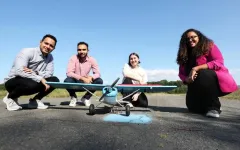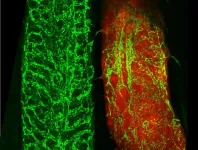(Press-News.org) Taking inspiration from bird feathers, Princeton engineers have found that adding rows of flaps to a remote-controlled aircraft’s wings improves flight performance and helps prevent stalling, a condition that can jeopardize a plane’s ability to stay aloft.
“These flaps can both help the plane avoid stall and make it easier to regain control when stall does occur,” said Aimy Wissa, assistant professor of mechanical and aerospace engineering and principal investigator of the study, published in the Proceedings of the National Academy of Sciences.
The flaps mimic a group of feathers, called covert feathers, that deploy when birds perform certain aerial maneuvers, such as landing or flying in a gust. Biologists have observed when and how these feathers deploy, but no studies have quantified the aerodynamic role of covert feathers during bird flight. Engineering studies have investigated covert-inspired flaps for improving engineered wing performance, but have mostly neglected that birds have multiple rows of covert feathers. The Princeton team has advanced the technology by demonstrating how sets of flaps work together and exploring the complex physics that governs the interaction.
Girguis Sedky, postdoctoral researcher and the paper’s lead author, called the technique “an easy and cost-effective way to drastically improve flight performance without additional power requirements.”
The covert flaps deploy or flip up in response to changes in airflow, requiring no external control mechanisms. They offer an inexpensive and lightweight method to increase flight performance without complex machinery. “They’re essentially just flexible flaps that, when designed and placed properly, can greatly improve a plane’s performance and stability,” Wissa said.
A wing’s teardrop form forces air to flow quickly over its top, creating a low-pressure area that pulls the plane up. At the same time, air pushes against the bottom of the wing, adding upward pressure. Designers call the combination of this pull and push “lift.” Changes in flight conditions or a drop in an aircraft’s speed can result in stall, rapidly reducing lift.
Wissa’s team designed a series of experiments in the wind tunnel at Princeton’s Forrestal Campus to understand how flaps mimicking the feathers would affect flight performance, especially near stall, which usually happens when the plane is at a steep angle, when covert feathers were observed to deploy. The tunnel allowed the team to examine the way different flap arrangements affected variables like air pressure around the wings, wind speed over the wing and vortices that impact performance.
The team attached the covert-inspired flaps to a 3D-printed model airplane wing and mounted it in the wind tunnel, a 30-foot-tall metal contraption that simulates and measures air flow. “The wind tunnel experiments give us really precise measurements for how air interacts with the wing and the flaps, and we can see what’s actually happening in terms of physics,” Sedky said.
The wind tunnel is equipped with sensors that read the forces felt by the wing, as well as a laser and high-speed camera that measure precisely how air is moving around the wing.
The study uncovered the physics by which the flaps improved lift and identified two ways that the flaps control air moving around the wing. One of these control mechanisms had not been previously identified. The researchers uncovered the new mechanism, called shear layer interaction, when they were testing the effect of a single flap near the front of the wing. They found that the other mechanism is only effective when the flap is at the back of the wing.
The researchers tested configurations with a single flap and with multiple flaps ranging from two rows to five rows. They found that the five-row configuration improved lift by 45%, reduced drag by 30% and enhanced the overall wing stability.
“The discovery of this new mechanism unlocked a secret behind why birds have these feathers near the front of the wings and how we can use these flaps for aircraft,” Wissa said. “Especially because we found that the more flaps you add to the front of the wing, the higher the performance benefit.”
Following the results of the wind tunnel experiments, the team moved outside the lab and into the field to test the covert-inspired flaps on a scaled model aircraft. Princeton’s Forrestal Campus was once an airport and still features an operational helipad. So, the researchers teamed up with Nathaniel Simon, graduate student in mechanical and aerospace engineering who researches drone flight, and demonstrated the technology in real-world conditions by equipping a radio-controlled (RC) airplane with covert-inspired flaps.
The researchers worked with members of the Somerset RC model aircraft club to select a model plane. The researchers then modified the airplane body to outfit it with an onboard flight computer, and Simon drew on his experience piloting drones to fly it. They programmed the flight computer to stall the aircraft autonomously and repeatedly. Simon said it was amazing to see the flaps deploy in-flight and to see that they helped delay and reduce stall intensity, just as they did in the wind tunnel. “It’s cool to be able to collaborate in the shared space at the Forrestal campus, and to see how many areas of research this project touched,” he said.
Sedky said that in addition to improving flight, their findings could be extended to other applications where modifying the surrounding fluid would benefit performance. “What we discovered about how coverts alter the airflow around the wing can be applied to other fluids and other bodies, making them applicable to cars, underwater vehicles, and even wind turbines,” he said.
Wissa said that this study could open the door to collaborations with biologists to learn more about the role of covert feathers in bird flight, and that the results of this study will help form new hypotheses that can be tested on birds. “That’s the power of bioinspired design,” she said. “The ability to transfer things from biology to engineering to improve our mechanical systems, but also use our engineering tools to answer questions about biology.”
The paper, “Distributed feather-inspired flow control mitigates stall and expands flight envelope,” by was published in the Proceedings of the National Academy of Sciences. Besides Wissa, Sedky and Simon, authors include Ahmed K. Othman, and Hannah Wiswell, graduate students in mechanical and aerospace engineering. Support for the project was provided in part by the National Science Foundation.
END
Bird wings inspire new approach to flight safety
2024-10-28
ELSE PRESS RELEASES FROM THIS DATE:
Global fleet of undersea robots reveal the phytoplankton hidden beneath the ocean's surface
2024-10-28
Marine phytoplankton are fundamental to Earth’s ecology and biogeochemistry. Our understanding of the large-scale dynamics of phytoplankton biomass has greatly benefited from, and is largely based on, satellite ocean color observations from which chlorophyll-a (Chla), a commonly used proxy for carbon biomass, can be estimated. However, ocean color satellites only measure a small portion of the surface ocean, meaning that subsurface phytoplankton biomass is not directly monitored. Chla is also an imperfect ...
Climate, dead zones and fish: Solving a 'wicked problem' in Lake Erie and beyond
2024-10-28
Images
There's a famous piece of advice from hockey, attributed to Wayne Gretzky, about how it's better to skate to where the puck is headed rather than where it is.
Research is now showing that regulations designed to protect Lake Erie's water quality are heeding the Great One's words when it comes to safeguarding the Great Lake's fisheries.
Specifically, the currently recommended limits on the flow of nutrients into Lake Erie from agriculture may be too restrictive for some species of fish. They are, however, suited to maintain healthy fisheries until the ...
Dinosaurs thrived after ice, not fire, says a new study of ancient volcanism
2024-10-28
201.6 million years ago, one of the Earth's five great mass extinctions took place, when three-quarters of all living species suddenly disappeared. The wipeout coincided with massive volcanic eruptions that split apart Pangaea, a giant continent then comprising almost all the planet's land. Millions of cubic miles of lava erupted over some 600,000 years, separating what are now the Americas, Europe and North Africa. It marked the end of the Triassic period and the beginning of the Jurassic, the period when dinosaurs arose to take the place of Triassic creatures and dominate the planet.
The exact mechanisms of the End Triassic Extinction have long been debated, ...
Green growth: 30% of regions worldwide achieve economic growth while reducing carbon emissions
2024-10-28
“We found that 30 percent of the regions with available data have fully decoupled carbon emissions from economic growth. Regions with high incomes and a history of carbon-intensive industries, as well as those with significant shares of service and manufacturing sectors were particularly successful in reducing carbon emissions while still experiencing economic growth,“ says Anders Levermann, co-author and head of the research department “Complexity Science” at PIK. “A stabilization of the global mean temperature is only possible with net-zero carbon emissions. That ...
Cellular couriers: Body's ‘delivery trucks’ could lead to new cancer blood test
2024-10-28
A landmark study led by WEHI and La Trobe University has found a potential new diagnostic marker that could be used to better detect the level of tissue damage in our bodies.
Extracellular vesicles (EVs) are small ‘delivery trucks’ released by our cells that deliver important materials to other cells to aid cellular communication. This study revealed, for the first time, a link between levels of EVs in the blood and tissue damage caused by diseases such as leukaemia.
Researchers hope to leverage the ...
Public and community engagement key to enhancing urban living conditions and environmental decision making in China, study says
2024-10-28
Public and community engagement in decision making is key to enhancing urban living conditions and the environment in China, a new study says.
There has been significant progress through legislation to promote the role of citizens in environment and nature-based solutions (NBS), but progress in involving the public in projects has been limited, the research shows.
However, there has been some work in gathering public opinion and involving them in the project design and decision-making of government-led and large NBS projects.
Researchers found smaller local NBS projects tend to see higher levels of public participation, ...
Bagheri to leverage recycled polyurethane foam for real-world applications
2024-10-28
Bagheri To Leverage Recycled Polyurethane Foam For Real-World Applications Shaghayegh Bagheri, Assistant Professor, Mechanical Engineering, College of Engineering and Computing (CEC), received funding for the project: “Leveraging Recycled Polyurethane Foam for Real-world Applications.”
Bagheri ...
Seeing a black hole's jet in a new light
2024-10-28
Image
Research led by the University of Michigan has pored over more than two decades' worth of data from NASA's Chandra X-Ray Observatory to show there's new knotty science to discover around black holes.
In particular, the study looks at the high-energy jet of particles being blasted across space by the supermassive black hole at the center of the galaxy Centaurus A.
Jets are visible to different types of telescopes, including those that detect radio waves and others that collect X-rays. Since Chandra's 1999 launch, many astronomers have been particularly interested ...
Experienced research leader tapped as CEO of Upstate New York Energy Storage Engine led by Binghamton University
2024-10-28
An engineer with decades of experience in industry and higher education will serve as the CEO of the Upstate New York Energy Storage Engine led by Binghamton University.
Meera Sampath, who holds a doctorate in electrical engineering from the University of Michigan, Ann Arbor, previously was the associate dean of research in Binghamton’s Thomas J. Watson College of Engineering and Applied Science.
Sampath spent the first 20 years of her career with Xerox Corp., including time as the vice president for innovation and business transformation at Xerox Services and as founding director of the Xerox Research Center India. From there, she ...
Lewis Katz School of Medicine at Temple University awarded nearly $1 million in PCORI funding to improve antibiotic prescribing for childhood respiratory infections
2024-10-28
(Philadelphia, PA) – A team at the Lewis Katz School of Medicine at Temple University, part of Temple Health, has been awarded nearly $1 million by the Patient-Centered Outcomes Research Institute (PCORI) to help improve antibiotic prescribing for children with acute respiratory tract infections.
“Many children with symptoms of upper respiratory tract illness who are taken to see a pediatrician end up being prescribed antibiotics, even though they aren’t always needed,” explained Janet Lee, MD, Associate Professor of Pediatrics, Lewis Katz School of Medicine. Dr. Lee and Claire Raab, MD, President ...






